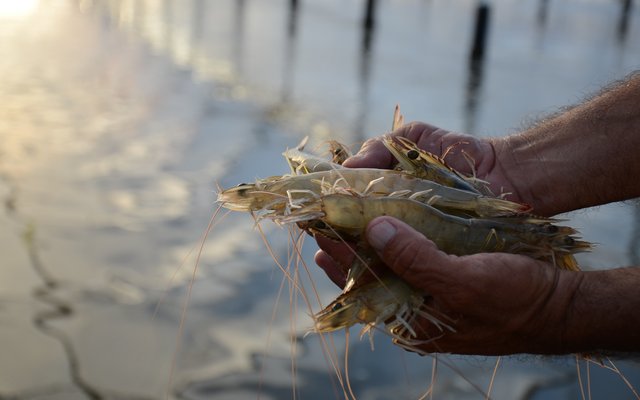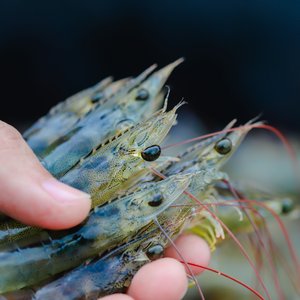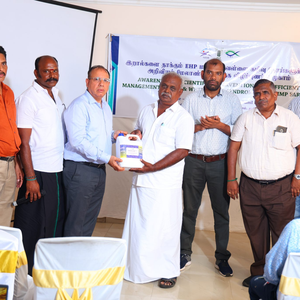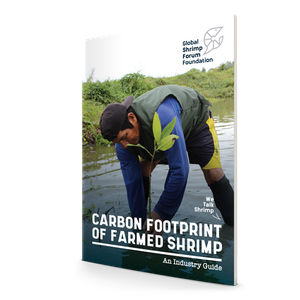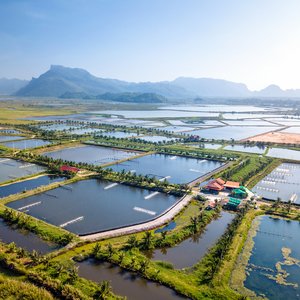Asian farmers are struggling to make shrimp farms profitable. Apart from prices, market demand and the economic context, there are technical issues that farmers can address to improve and increase profitability.
Diseases
The key issue for Asian shrimp farmers to overcome is production losses due to diseases.
“The key pathogens challenging our industry globally at present are EHP, AHPND/EMS and WSSV, with IMNV being a significant problem in some countries. After these are the usual suspects causing reduced production performance, IHHNV and HPV, and in some countries GAV and YHV7,” explained Melony Sellars, CEO and managing director at Genics.
“This can be improved in several ways: genetics with breeders placing greater emphasis on selection for disease-resistance; improvements in the biosecurity of existing production facilities (hatcheries and farms); and moving from open, outdoor flow-through pond systems toward indoor recirculating grow-out systems,” said Jeffrey Prochaska, breeding scientist at the Center for Aquaculture Technologies.
Genetics
“Disease affects all countries in one way or another, even Ecuador. What has been different in Ecuador is that this country is focusing on stocking animals based on high survival. In Asia, farmers are generally stocking for faster growth, which is just not as hardy. The key is disease is not going away, and the sooner the Asian farmers adopt to using animals with high survival over growth, the sooner they will start getting better production,” said Robin Pearl, CEO of American Penaeid.
Apart from adopting the Ecuadorean model, the quality of PLs is also important. “If PLs come from the hatchery infected with EHP, the farmer is defeated before he begins. Paying a bit more for the highest quality and most robust PL is an investment a farmer should never pass up. However, even with the best stocks, it all comes down to production efficiency and scientific farming techniques. For example, in Ecuador, the application of electrification and automatic feeding technologies have driven increasing shrimp production, pressuring prices worldwide, and driving industry consolidation,” said Ramir Lee, Regional Technical Manager, Zeigler Bros., Inc.
Biosecurity
“In terms of broodstock, we can learn from Ecuador that animals carrying pathogens do not perform as well in maturation as those that do not carry pathogens, and that progeny from pathogen-positive broodstock do not perform as well in commercial grow-out ponds compared to pathogen-negative broodstock, despite their robust genetic history,” Sellars said.
“PL stocking into nursery and/or grow-out ponds should always be tested on a PCR platform and test negative before stocking. The design of a statistically sound sampling program in addition to utilizing a highly sensitive accurate PCR testing platform is also critical to ensure decisions are being made on the highest quality data possible,” Sellars said.
“Controlling the water quality and keeping water clean throughout the entire production process is key for improving the performance, growth and efficiency of shrimp. Water treatment processes with probiotics (bioremediation) also play an integral role in how farmers control and mitigate pollution within the water to help reduce the risk of disease. Some shrimp feeds also contain probiotics that support the gut of animals and help reduce the risk from pathogenic bacteria in the digestive system,” said Thomas Raynaud, head of product management - aquaculture, ADM Animal Nutrition.
“Farms are all sited on top of each other. One farm’s untreated effluent may become another farm's influent. Farms should not be allowed to be built on top of each other. There should be buffer zones between them. They should not be allowed to discharge effluents that have not been held in sedimentation ponds and in the event of disease outbreaks, they should be forced to shut down and notify their neighbors of problems,” Stephen Newman, CEO of AquaInTech, said.
“It is not all about improvement. Solutions for better disease management have been there all the time, and everyone has been exposed to robust recommendations on biosecurity and facility management improvements for disease control. Nevertheless, there are still many hatcheries that are using infected live and frozen feeds for their breeders. Why is that? It’s all about profitability and maintaining maximum nauplii output and dealing with the rest later,” Lee stated. “Some hatcheries prioritize short-term profits over the long-term health of the industry. With this mindset, and without increasing regard for sustainability and a longer-term view, change cannot occur.”
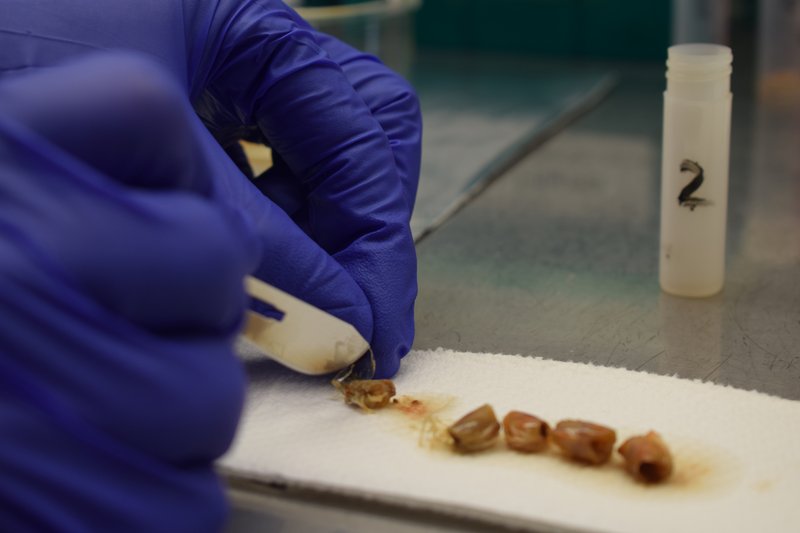
Credits: Genics
Management
The size of the farm itself and the density of production are other challenges that can increase the risk of disease. “The biggest difference between hatcheries in APAC and LATAM is the size of the operation. Intensive system ponds with a larger density of shrimp must evaluate how to manage both health and disease. The higher the density of the animal, means more stress is being created, which ultimately reduces immunity and resilience to disease. This is a challenge for many large farms in APAC where shrimp density measures approximately and at minimum 100 shrimp/m2. On the other hand, semi-extensive model farms in Ecuador are able to reduce the risk of disease by keeping shrimp populations smaller, nearer to natural conditions. On average, shrimp density in Ecuador measures 40 shrimp/m2,” Raynaud said.
“Farmers need to understand the concept of carrying capacity, stay within those boundaries and apply carrying capacity to a pond, a farm and a region. This is paramount to making the shrimp industry healthy again,” said Robins McIntosh, executive vice president, Charoen Pokphand Foods (CPF) Public Company.
For PL management, Sellars suggests the implementation of nursery rearing systems under some circumstances to reduce disease impact. “Asian farmers may benefit from considering the installation of low-cost nursery systems to take their PL10/12 animals through to PL25/30 before stocking into commercial grow-out ponds.”
A nutritional approach can also support resilience and performance in shrimp farming. “Nutrition scientists are finding new ways to tailor feed formulations to specific stressors, including supporting immunity, as well as incorporating ingredients with demonstrated benefits to support shrimp growth and resilience,” said Raynaud.
“New management tools and technologies can significantly improve the efficiency and productivity of shrimp farms and hatcheries. While many of the big farmers can adopt these technological advances, some of the smaller farmers won’t have the capability to do so and need help. We have seen it in Vietnam helping customers facing water management challenges. Advanced extrusion technology, which makes shrimp feeds highly water resistant leaving behind minimum residues, has ensured consistently clean ponds, reducing the burden of water treatment, especially during monsoon season,” said Angel Gomez, managing director Cargill Aqua Nutrition Latam North.
Back to monodon
Some farmers are moving to monodon due to vannamei low profitability or market demands. “Monodon’s revival is likely driven more by the market than by biological advantages of the species. Traditionally, it has been considered a less efficient feed converter which requires higher protein feeds,” David Danson, director of operations and shrimp at Hendrix Genetics, said.
“With monodon you need more fishmeal in the feed, whereas vannamei helps reduce marine protein and therefore, the overall carbon footprint of the industry,” said Gomez.
Current monodon production has proven to have a lot of potential, but it has also proven that it cannot compete with vannamei production. “Monodon can only survive as a differentiated product and be grown under low-density conditions. It is not a species adapted to high-density production systems. The other main challenge is the low number of companies that can provide large amounts of good genetic shrimp, adapted to the different conditions where current shrimp is taking place. The monodon genetic programs have only recently matured and there is still a long way to reach the level that vannamei genetics have,” Marcos De Donato, breeding scientist at the Center for Aquaculture Technologies, said.
“The main challenges might be to respect the carrying capacity of the farming systems and keep the stocking densities at acceptable levels to avoid water quality and health issues that occurred with vannamei,” said Jonas Keitel, researcher, shrimp and warm water species, at Skretting.
“Diversification is a good outcome of the market trend with some farmers moving to (or back to) P. monodon. There will certainly be demand for more high-quality broodstock beyond where the current supply sits, however, there are some established successful P. monodon programs that may be able to meet this demand when scaled appropriately. A key challenge for the industry will be finding and training team members in the skill of growing P. monodon which is very different to L. vannamei,” Sellars said.
“Monodon aquafeeds, in association with the correct pond management, allow a very profitable business. The main challenge for monodon is the reduced market size compared to that of vannamei. Monodon is mostly consumed in Asia. As a consequence, there is a smaller market, yet premium, that could be filled quickly if a large number of farmers switch to that species,” said Olivier Decamp, group technical director at Grobest.
“The reason why farmers abandoned monodon is because of disease and low survival. These issues are still there. A farmer who is having issues with growing vannamei will not miraculously solve his/her problems by switching to monodon,” Pearl said.
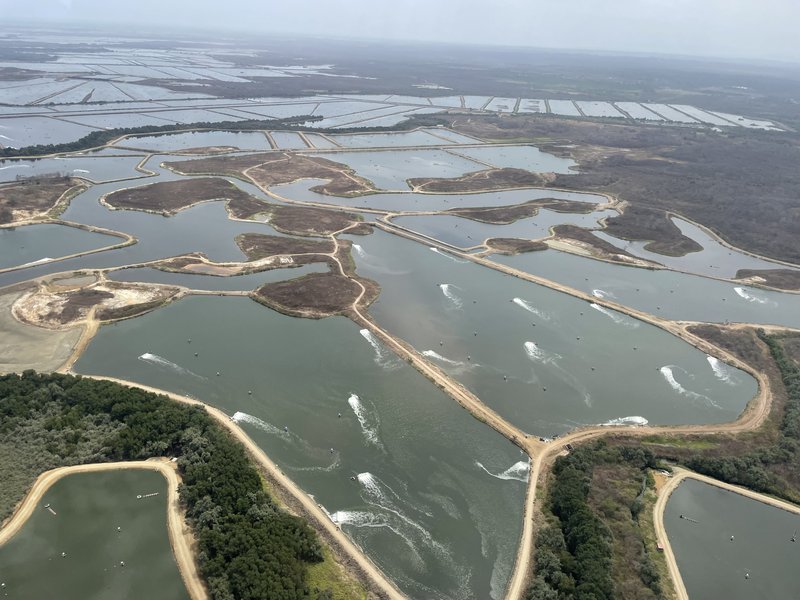
Ecuador ponds. Credits: Genics
Ecuador
A big part of Ecuador's success has been the management and containment of diseases. “Density is key, as most production in Ecuador is below 20 shrimp/m2. There are more sustainable systems, deeper ponds and plenty of water resources,” Gomez explained. “In addition, Ecuador doesn’t work with SPF, but instead with disease-tolerant strains selected through mass selection. There is also continuous improvement in management and the incorporation of automatic feeding systems and solar systems that help monitor and track when the shrimp are eating. The combination of tapping into new technology and safeguarding the animal’s welfare help give Ecuador an edge.”
Despite this success of the Ecuadorean shrimp farming industry, there is still room for improvement from a technical point of view as well as future challenges.
“Ecuador’s ability to double production simply through production intensification (14-20/m2 to 40-60/m2) is unstoppable once reliable power supply to farms is resolved, enabling aeration, feeding systems, etc. However, a critical factor that may determine Ecuador’s longer-term ability to sustain such growth and remain profitable could well be driven by the source of energy in use, with diesel subsidies being unstable and taking a farm from profit to loss overnight. Education and training of farmers in Ecuador on how to manage shrimp [and the ponds] when grown at higher densities will play a critical role,” Sellars said.
“Ecuador has been increasing its stocking density. They started at a very low density to begin with, thus the additional stocking density created the increases. The challenge for Ecuador is not to push the density too much because then they will start experiencing similar challenges their Asian competitors are seeing,” Pearl said.
The genetic lines still have a lot of room for improvement. “Knowing that they have large genetic variability and that now genomic selection technology is being used in the main genetic programs, there will be a great improvement in growth and survival, keeping the system low cost and highly productive. The only limitation for faster production expansion will be feed cost and shrimp price because their systems are not the most efficient, thus the margins can get very small, even can put production in the losing chart. Thus, for the production to continue to grow, better genetics coupled with more efficient systems will have to happen,” said De Donato.
Intensification by incorporating aeration, advanced feed formulations, and feeding systems would allow increased production. “Trend numbers, looking at technified ponds vs. non-technified ponds would indicate the country could go over 5 million tons. But will the natural laws of carrying capacity allow this? That is the million-dollar question for Ecuador and the world. When it is enough, is enough,” McIntosh concluded.
Don't miss the previous articles in this series:
A look at salmon farming: Genetics, disease resistance and RAS
Tilapia farming I: Genetics, diseases and scale challenges
Tilapia farming II: A look at the main producing countries


